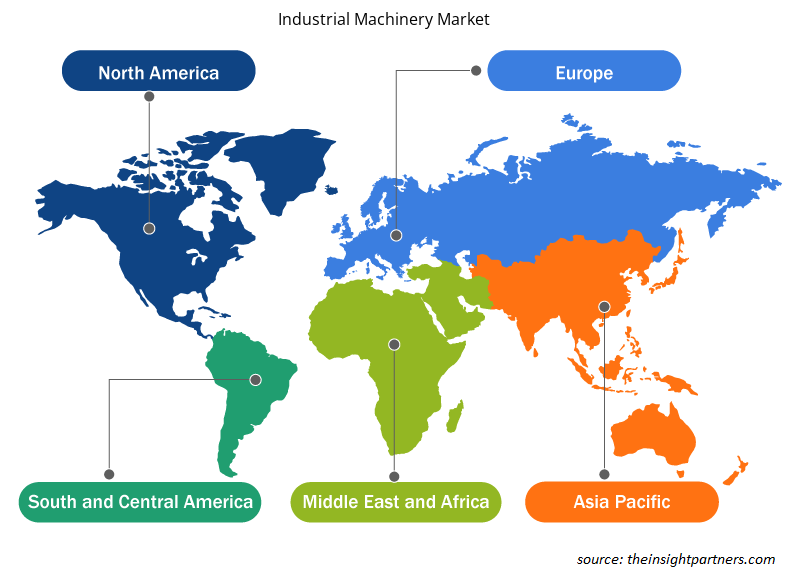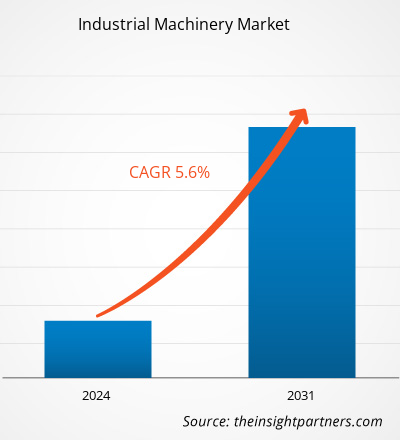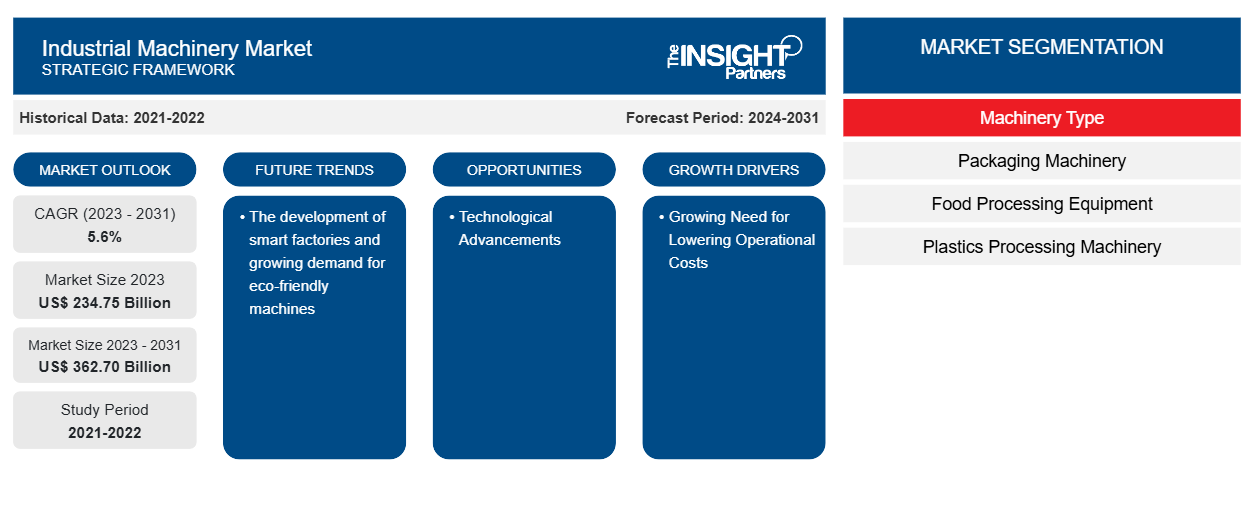産業機械市場規模は、2023年の2,347.5億米ドルから2031年には3,627億米ドルに達すると予測されています。市場は2023年から2031年にかけて5.6%のCAGRを記録すると予想されています。スマートファクトリーの開発と環境に優しい機械の需要の高まりは、今後も産業機械市場の主要なトレンドであり続けると思われます。
産業機械市場分析
産業機械市場は、運用コストの削減ニーズの高まりと、自動車、食品・飲料、製薬、製造、その他の業界からの産業機械の採用の増加により、急速に成長しています。市場は、都市化と産業オートメーションの拡大に牽引され、着実に拡大しています。さらに、技術の進歩とAIと3Dデジタル印刷技術の統合により、市場の成長に有利な機会が生まれています。
産業機械市場の概要
産業機械とは、特定の機能を実行し、特定の結果を生み出すために設計および使用される機械的、電気的、または電子的な機器を指します。製造工場のメーカーは、これらの機械を使用して、切断、成形、形成、積層、または生産プロセスの調整を行います。産業機械は、世界中の産業活動をサポートする上で重要な役割を果たしています。デジタル化の進展、技術の進歩、およびインダストリー 4.0 イニシアチブにより、市場にチャンスが生まれています。
要件に合わせてレポートをカスタマイズする
このレポートの一部、国レベルの分析、Excelデータパックなど、あらゆるレポートを無料でカスタマイズできます。また、スタートアップや大学向けのお得なオファーや割引もご利用いただけます。
-
このレポートの主要な市場動向を入手してください。この無料サンプルには、市場動向から見積もりや予測に至るまでのデータ分析が含まれます。
産業機械市場の推進要因と機会
運用コスト削減のニーズの高まりが市場を牽引
運用コストの削減は利益率の向上につながり、企業はコスト削減の取り組みを通じて製品の提供を多様化し、新しい市場に参入できるようになります。企業の間で運用コストを削減するニーズが高まるにつれて、技術的に高度な機械の需要が高まります。メーカーはこれらのデバイスに IoT アプリケーションを統合して、リモート監視、中央フィードバック システム、その他の機能などの強化されたサービスを提供しています。さらに、メーカーは強化されたセンサー、モバイル アプリ、組み込みソフトウェアも採用して、全体的なビジネス コストを削減することで運用プロセスを合理化し、市場を牽引しています。
技術の進歩 – 産業機械市場におけるチャンス
予測期間中、急速な技術進歩により産業機械市場の革新が促進されると予想されます。さらに、製造業は、運用コストの削減、生産性の向上、利益の増加を目的として、人工知能、3D プリント、ビッグデータ分析などの先進技術を採用しています。しかし、3D プリントと AI 技術の潜在的な統合により、産業機械市場に存在する国際的および国内のプレーヤーの両方に成長の機会が生まれています。
産業機械市場レポートのセグメンテーション分析
産業機械市場分析の導出に貢献した主要セグメントは機械の種類です。
- 機械の種類に基づいて、産業機械市場は、包装機械、食品加工機器、プラスチック加工機械、金属成形工作機械、木工機械に分類されます。
- 包装機械部門は、充填機、パレタイジング機、ラベリング機、ラッピング機、その他に細分化されています。食品加工機械部門は、スライサー・ダイサー、押し出し機、デポジター・ミキサー、貯蔵・冷蔵機器、その他に細分化されています。プラスチック加工機械部門は、検査成形機、ブロー成形機、押し出し成形機、その他に細分化されています。金属成形工作機械部門は、加圧機、曲げ機、鋳造機、打ち抜き機、その他に細分化されています。木工機械部門は、旋盤機、研削盤、帯鋸盤、その他に細分化されています。
産業機械の地域別市場シェア分析
産業機械市場レポートの地理的範囲は、主に北米、アジア太平洋、ヨーロッパ、中東およびアフリカ、南米/中南米の 5 つの地域に分かれています。
収益面では、交通、エネルギー、都市開発などのインフラプロジェクトへの投資増加により、アジア太平洋地域が最大の産業機械市場シェアを占めています。建設機械、土木機械、資材搬送機械など、さまざまな産業機器の需要が高まっており、この地域の市場が活況を呈しています。
産業機械市場の地域別洞察
予測期間を通じて産業機械市場に影響を与える地域的な傾向と要因は、Insight Partners のアナリストによって徹底的に説明されています。このセクションでは、北米、ヨーロッパ、アジア太平洋、中東、アフリカ、南米、中米にわたる産業機械市場のセグメントと地理についても説明します。

- 産業機械市場の地域別データを入手
産業機械市場レポートの範囲
| レポート属性 | 詳細 |
|---|---|
| 2023年の市場規模 | 2,347.5億米ドル |
| 2031年までの市場規模 | 3,627億ドル |
| 世界のCAGR(2023年~2031年) | 5.6% |
| 履歴データ | 2021-2022 |
| 予測期間 | 2024-2031 |
| 対象セグメント |
機械の種類別
|
| 対象地域と国 |
北米
|
| 市場リーダーと主要企業プロフィール |
|
産業機械市場のプレーヤー密度:ビジネスダイナミクスへの影響を理解する
産業機械市場は、消費者の嗜好の変化、技術の進歩、製品の利点に対する認識の高まりなどの要因により、エンドユーザーの需要が高まり、急速に成長しています。需要が高まるにつれて、企業は提供を拡大し、消費者のニーズを満たすために革新し、新たなトレンドを活用し、市場の成長をさらに促進しています。
市場プレーヤー密度とは、特定の市場または業界内で活動している企業または会社の分布を指します。これは、特定の市場スペースに、その規模または総市場価値と比較して、どれだけの競合相手 (市場プレーヤー) が存在するかを示します。
産業機械市場で事業を展開している主要企業は次のとおりです。
- ABエレクトロラックス
- アルファ・ラバル
- 株式会社アマダ
- GEAグループ
- ハイチ国際
- 三菱重工業株式会社
免責事項:上記の企業は、特定の順序でランク付けされていません。

- 産業機械市場のトップキープレーヤーの概要を入手
産業機械市場のニュースと最近の動向
産業機械市場は、主要な企業出版物、協会データ、データベースなどの一次調査と二次調査を経て定性的および定量的データを収集することで評価されます。以下は、産業機械市場の動向と戦略のリストです。
- 2022 年 11 月、インガソール ランドは産業用途向けの 135MAX ヘビーデューティー エア ハンマーを発売しました。135MAX HD エア ハンマーは、119MAX の基盤を基に構築された次世代のエア ハンマーで、手頃な価格で驚異的なパフォーマンスとパワーを提供します。また、伝説的なインガソール ランドのインパクト レンチにヒントを得た微調整可能なフェザブル トリガーを活用して、精度と結果をさらに向上させます。(出典: インガソール ランド、プレス リリース、2022 年)
産業機械市場レポートの対象範囲と成果物
「産業機械市場の規模と予測(2021〜2031年)」レポートでは、以下の分野をカバーする市場の詳細な分析を提供しています。
- 対象範囲に含まれるすべての主要市場セグメントの世界、地域、国レベルでの市場規模と予測
- 市場の動向(推進要因、制約、主要な機会など)
- 今後の主な動向
- 詳細なPEST/ポーターの5つの力とSWOT分析
- 主要な市場動向、主要プレーヤー、規制、最近の市場動向を網羅した世界および地域の市場分析
- 市場集中、ヒートマップ分析、主要プレーヤー、最近の動向を網羅した業界の状況と競争分析
- 詳細な企業プロフィール
- 過去2年間の分析、基準年、CAGRによる予測(7年間)
- PEST分析とSWOT分析
- 市場規模価値/数量 - 世界、地域、国
- 業界と競争環境
- Excel データセット
最新レポート
お客様の声
購入理由
- 情報に基づいた意思決定
- 市場動向の理解
- 競合分析
- 顧客インサイト
- 市場予測
- リスク軽減
- 戦略計画
- 投資の正当性
- 新興市場の特定
- マーケティング戦略の強化
- 業務効率の向上
- 規制動向への対応























 無料サンプルを入手 - 産業機械市場
無料サンプルを入手 - 産業機械市場